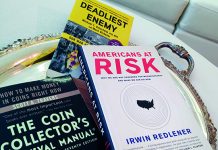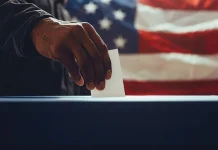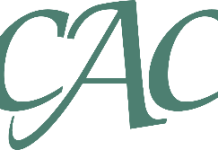
By Mike Garofalo
Nearly 2,500 miles to the southeast, off of the coast of California, lay the Hawaiian Islands. Hawaii is a group of eight islands and is believed to have been first settled sometime between 300 to 600 AD by Polynesians from the Marquesas Islands.
The history of the Hawaiian Islands, in many respects, has similarities to that of the United States.
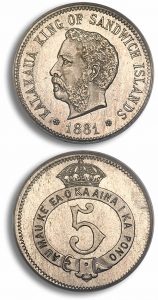
Just as Italian explorer Christopher Columbus “discovered” America, much to the chagrin of the native peoples already living there, British explorer Captain James Cook “discovered” the Hawaiian Islands. Again, this “discovery” was much to the chagrin of the indigenous Hawaiians already living there and who may have been there for more than 1,000 years prior. Cook promptly renamed them the Sandwich Islands after the Earl of Sandwich. That name disappeared in the 1840s, replaced by the Hawaiian Islands.
But just as America had no native coins or currency when the European settlers began to move there, neither did Hawaii in the earliest of days. Bartering was commonplace in the early colonies, but with people coming from different countries and bringing their valuables with them, American trade using coins began to flourish by using British Sovereigns, Dutch Guilders, Spanish Escudos, and other coinage.
Likewise, as British sailors came to and settled in Hawaii, the use of British coinage and denominations began to dominate trade there as well. But items such as Cowry shells, certain types of feathers, and, later, sandalwood are all reported to have been used as exchange before the British had landed there and later when foreign coinage was in short supply.
King Kamehameha I served as the first ruler of the Kingdom of Hawaii. Although multiple dates have been offered, the accepted year of his birth was around 1736. His mother was the niece of the usurping ruler of Hawaii at that time, and he was adopted as his infant son and heir. King Kamehameha I was the first ruler to recognize the value of gold and silver coinage as money. One of his sons, King Kamehameha III, succeeded him and wanted to establish a local coinage as opposed to using foreign coinage.
Early Monetary System
Kamehameha III established a monetary system for use in Hawaii, and he tied it to the U.S. dollar and coinage. He created a “Keneta”—a one-cent coin much like a U.S. large cent. The king planned to have a large quantity of this low-denomination coin minted and, once they were acceptable to the Hawaiian population, to introduce several larger denominations.
The Keneta is roughly the same diameter as the large cent. The obverse bears a military bust of the king, facing front, with the legend “KAMEHAMEHA III. K.A. MOI.” around him and the date, 1847, below. The reverse has the denomination “HAPA HANERI” within a wreath, tied with a bow at the bottom, surrounded by “AUPUNI HAWAII.” There are two different obverse varieties—one has a Plain 4 in the date, and the other has a Crosslet 4. There are also six separate varieties of reverse dies.
It was agreed that 100,000 of these Keneta coins would be struck by H.M. & E. I. Richards of Attleboro, Mass. This company had struck several Hard Times tokens and as such were respected private minters.
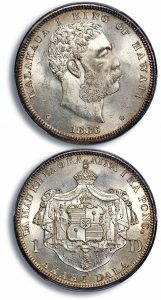
The coins left the port of Boston on the merchant ship S.S. Montreal. The vessel took the path from Boston that included sailing south down the eastern coast of America, south past Central America, and skirting the east coast of South America. The ship made a planned stop at Rio de Janeiro and then sailed south, coming around the tip of South America at Tierra del Fuego. Now the Montreal headed north along the coast of South America and then at Santiago, Chile, headed due west across the Pacific to Tahiti. That was the last stop before docking in Honolulu. But after five months aboard the humid and wet ship, many of the copper coins were badly discolored.
But that was not the worst discovery, by the king’s standards. His portrait was a disappointing likeness, as it was not recognizable by his subjects. These various matters certainly put the coins on a wrong trajectory. It took several years before even a small number of the 100,000 coins were disbursed. More than 88,305 coins were eventually shipped out of Hawaii and scrapped. The Keneta experiment was not a rousing success then, but today the coins are considered scarce and valuable.
Given the results of this first round of coin production, the next coinage experiment would not occur for 34 years. In 1881, while traveling throughout Europe, then-King Kalakaua was approached by French Mint officials, who convinced him that the Kingdom of Hawaii required its own coinage to be a sovereign nation indeed. The king was convinced, and he ordered 200 pattern five-cent coins to be struck and shipped to him. Interestingly, he allowed the English name “Sandwich Islands” to be utilized on the obverse.
The obverse of the pattern coin would featured a bust of the king facing left and “KALAKAUA KING OF SANDWICH ISLANDS” surmounting the king and the date “1881” below him. The reverse displayed the Crown of Hawaii and the long Hawaiian Motto encircling the numeral “5.” But here again, an engraver’s mistake incorrectly spelled the first word in the Hawaiian Motto “U.A.” as “A.U.” When that was discovered, the coins were rejected out of hand.
The five-cent fiasco, however, did not deter King Kalakaua. Although American coins were circulating throughout the Islands, the king truly wanted the kingdom to have its coinage. This time, the king turned to a trusted friend of his, Claus Spreckels, to negotiate and mediate negotiations between the kingdom and the United States Mint. The Hawaiian Coinage Law passed in 1880 and called for creating a dollar, a fifty-cent piece, a twenty-five cent coin, and a twelve-and-one-half-cent coins.
Spreckels began corresponding with the director of the U.S. Mint, Horatio Burchard. Burchard advised him that the U.S. Mint would strike coinage for Hawaii. The dies would need to be engraved in Philadelphia, and after they were approved, the dies would be sent to San Francisco for minting. He asked Spreckels to provide him with sketches of the king, whose portrait would grace the obverse of all coins’ denominations. The sketches were received and rejected by Charles E. Barber, the Chief Engraver of the U.S. Mint, as they were full face. After additional negotiations, Spreckels provided profile sketches, which would be compatible with U.S. and other world coinage designs in that manner.
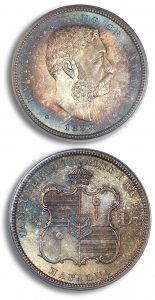
After approval, Barber sent dies to San Francisco for striking. The one-dollar coin depicted a bust of King Kalakaua facing right. Above him are his name and “KING OF HAWAII.” The date, 1883, which is below the bust, is offset with two periods, one on either side of the date. The reverse displays the Royal Arms’ shield emblazoned on a mantle. Above the shield is the Royal Crown and the Star of Kamehameha suspended below the shield. Surmounting the shield is the motto of Hawaii, and the denomination in English “1 D” is below the motto. The denomination in Hawaiian appears at the bottom of the coin—”AKAHI DALA.” The complete mintage of 500,000 silver dollars were struck at San Francisco.
The next coin struck was the Hawaiian fifty-cent piece. All told, 700,000 of those coins were struck and shipped to the kingdom. The obverse design was the same as that on the dollar, other than being smaller in size. The reverse was changed to display the Royal Arms with the Crown above it simply. These elements are not displayed on the previous mantle, nor is the Star of Kamehameha shown at all. The denomination is displayed as “1/2 D” in English and in Hawaiian as “HAPALUA.”
The Mint struck 500,000 Hawaiian quarter dollars. The design exactly matched that of the half dollar, except in size, and the denomination is expressed on the reverse as “1/4 D” in English and as “HAPAHA” in Hawaiian.
Although the Mint struck 26 Proof examples of each of the four major denominations, they also struck 20 Proof specimens of the twelve-and-one-half-cent coins. The coins had a unique reverse in that the motto of Hawaii surmounted the design. The Royal Crown was below the motto but not inside the wreath. Inside the wreath was the Hawaiian denomination “HAPAWALU,” and at the bottom of the coin was “EIGHTH DOL.” These Proof coins were intended for Members of Congress, Hawaiian officials, and members of the royal family.
Finally, for the Hawaiian ten-cent coin, the U.S. Mint had 250,000 coins struck. It followed the twelve-and-one-half-cent coin design, except for the denomination “ONE DIME” inside the wreath and the Hawaiian version, “UMI KENETA,” at the bottom. It bore a very close resemblance to the U.S. Barber dime of the day.
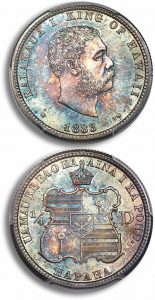
With all of this new coinage circulating through the islands, the foreign silver coins were essentially exchanged out of circulation for the desirable Hawaiian coinage. By the end of the 1880s, Hawaiian coinage had even replaced U.S. coins, which had been the most wanted coinage for the previous two decades.
By the 1890s, the Hawaiian population, led by foreign residents and some U.S. citizens, was displeased with the monarchy, and it finally fell. The Islands declared their autonomy as a Republic on July 4, 1894. Yet during that period, the coinage, even while bearing portraits of prior monarchs, remained the symbol of stability.
By 1898, the Republic of Hawaii was no more, and the United States annexed it as an Official Territory. In 1903, Congress decreed that as of January 1, 1904, all Hawaiian silver coinage had to be exchanged for U.S. coinage. With the exchange complete, nearly $814,000 of the original $1,000,000 face value of Hawaiian coinage had been returned to the United States Mint in San Francisco, where it was melted and remanufactured into U.S. coins. Less than $190,000 worth of face value Hawaiian coinage remained in existence.
The Hawaiian Proof coins that exist today are exceptionally rare and usually are sold at major auctions or by private treaty by a major dealer to an important collector. The Hawaiian Proof coinage in the Garrett Collection, including a Proof dime, Proof dollar, and a Proof pattern dollar, were all sold to benefit Johns Hopkins University in 1981. They brought record prices at the time.
Plantation Tokens
Like most agrarian economies, when coinage was not available, the plantations themselves created “money” that could be used as cash within the company stores that sprang up. Many of these Hawaiian tokens are well-known and widely collected today.
One of the earliest plantation tokens is the John Thomas Waterhouse Token (circa 1855—1860). It was struck in white metal, a metallic compound similar to pewter. J. T. Waterhouse was founded in 1851, and the company still survives today.
Waterhouse had an unknown number of tokens struck to be used in their company store on the grounds of their plantation. The token’s obverse displays a full-facing bust of King Kamehameha III, but the surrounding legends on the token incorrectly describe him as “HIS MAJESTY KING KAMEHAMEHA IV.” The reverse of the token displays a beehive, representing industry, with the issuer’s name above “JOHN THOMAS WATERHOUSE IMPORTER” and the Hawaiian expression “HALE MAIKAI,” meaning “house excellent” (i.e., a good place to do business), at the bottom.
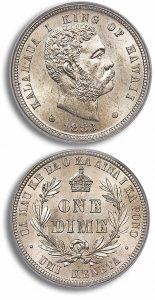
Additionally, tokens were struck in very limited quantities for the Grove Ranch Plantation and in numerous denominations, but limited in number, for the Kahului Railroad as transportation fares.
I have a mainlander’s view of Hawaiian coinage since I have been purchasing it and selling it for over four decades. But to get a different perspective, I spoke with Craig Watanabe. Craig is president of Captain Cook Coin Company of Honolulu. He has been in business for more than 50 years. Craig has seen many changes to both the coin hobby and to Hawaiian coinage.
Watanabe commented as follows: “Between the 1960s and about 1990, many Hawaiian coin dealers, including myself, actively promoted Hawaiian coinage and offered Buying and Selling Prices to the public. But with the onset of the grading services, many Hawaiian coins and tokens were upgradeable, as a good number of them had been cleaned. I learned that the true collectors wanted one of each denomination of Hawaiian coinage. Having the history of these coins in the Red Book (A Guide Book of United States Coins—Whitman Publishing), and now having current pricing in the Coin Dealer Newsletter, has greatly helped collectors and dealers formulate their own pricing and collecting strategies. I feel that much of the surviving mintage of Hawaiian coins is still in Hawaii. But many of these coins have been cleaned, especially the 1847 cents, as the climate of Hawaii is unfriendly to copper.”
I agree with many of Watanabe’s comments, but my experience has shown me that Hawaii, California, and other West Coast dealers are more likely to have Hawaiian coinage in their inventory than East Coast dealers. Many of the surviving uncleaned, high-grade specimens already reside in PCGS or NGC holders.
My advice to a collector today is to look for uncleaned coins with attractive toning or ones with eye appeal and, whether they have been certified or not, to seriously consider them if they are priced near these current levels. The surviving numbers of available coins are low, and finding these historic coins priced near Greysheet levels seems like a smart purchase over the long-term. Aloha!
Mike Garofalo has been a coin dealer for over 40 years and recently retired as Director of Numismatics from APMEX. He has been both a wholesale dealer and a retailer. A prolific writer, he enjoys bringing to light previously unknown numismatic facts. He can be reached at Mike@NumismaticAuthor.com.
Article courtesy of CDN Publications, John Feigenbaum, Publisher — Copyright 2020 by CDN Publications, trusted by dealers and collectors since 1963 — www.greysheet.com.


